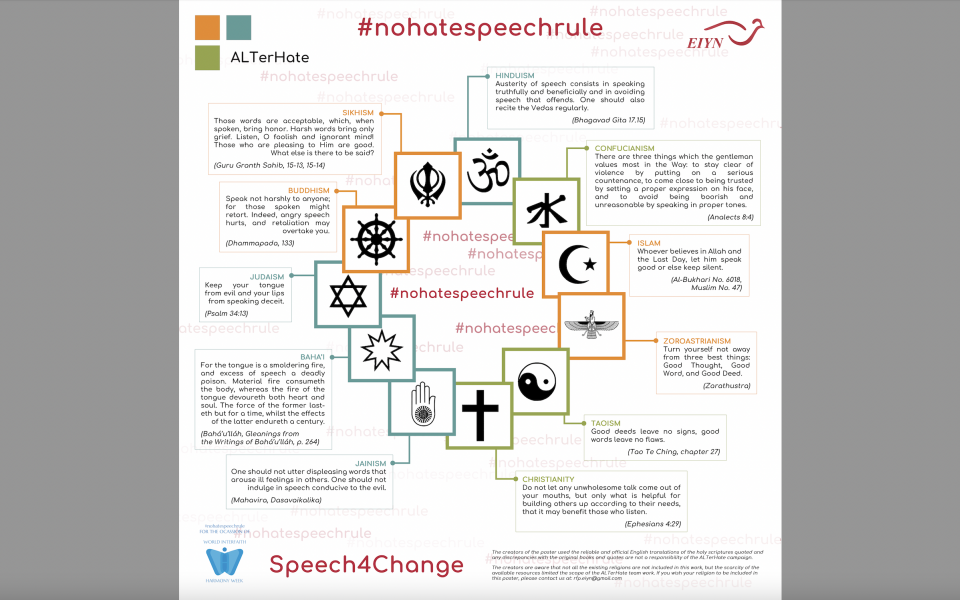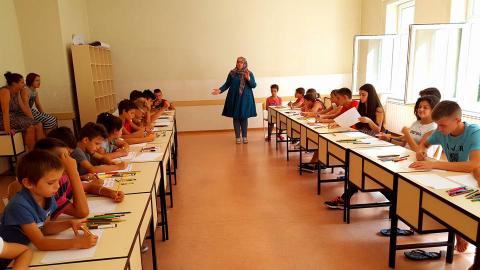
Poster from the ALTer Hate campaign, which aims to counter hate speech through activities of education, sensitization, and advocating the acceptance of diversity and inclusion through counter and alternative narratives.
Article written by Emina Frljak, Program Coordinator for Youth for Peace CC, Bosnia and Herzegovina:
Hate speech could be described as a deeply rooted malady that humanity suffers from probably since its very beginnings. It has just changed forms and expressions throughout history as well as the way we name it. Bensch states that hate speech “is like a disease that afflicts only certain populations, it can cause some people to suffer greatly, while others remain unaware and unsympathetic. It gives rise to both psychological and physical harm” (Bensch, 2014:19).
Many would say it’s just words… but words can hurt, and words can and do turn into action. From “harmless” hate speech, we come to not so harmless hate crimes… on a small, or on a big scale, even on a scale of genocide…Unfortunately, many examples from our past and present show how hate speech preceded some of the largest atrocities humanity suffered. From Holocaust through Rwanda in the 90’s, to the persecution of Rohingya Muslims since 2012. Hateful rhetoric in leaflets, radio, television, printed, and social media provided the basis for some of the most difficult crimes.
Defining hate speech is quite a struggle since there is no universal definition. There are definitions from the Council of Europe, UN, ECRI, and many others from different organizations dealing with hate speech. Here I am relying on the working definition proposed by UN in which
“the term hate speech is understood as any kind of communication in speech, writing or behavior, that attacks or uses pejorative or discriminatory language with reference to a person or a group on the basis of who they are, in other words, based on their religion, ethnicity, nationality, race, color, descent, gender or other identity factors. This is often rooted in, and generates intolerance and hatred and, in certain contexts, can be demeaning and divisive” (United Nations Strategy and Plan of Action on Hate Speech, 2019: 2).
While all hate speech may not necessarily turn into violent action, hate speech can have serious consequences that aren't visible. There are great psychological consequences hate speech leaves on those targeted, but also on those who perpetrate it. This has been exacerbated by new media forms that provide a platform for spreading hate speech much faster than before.
So what is the role of religious actors in addressing hate speech? By religious actors I mean religious leaders (senior ones, but also those working on local levels), faith-based organizations (international, national, and local ones), faith-based communities i.e., communities or groups who identify with a particular belief system or faith, women’s and youth groups within different religious and interreligious platforms and organizations, and people of faith who practice their religion and define their life by it.
Some might find this typology too broad, but I want to be sure to include everybody, since many things are happening on various levels.
To counter hate speech, it takes carefully planned actions, and it takes ALL OF US.
I find religious actors as extremely important in this field, since they have a wide reach of audience and influence on people, they work within the very communities, and they are trusted. “Spiritual values drive more than 80% of the people living on earth, giving faith leadership perhaps unparalleled capacity to influence individual behaviors. FBOs are close to their communities which see them as being trustworthy with a high level of credibility. This combined with the local networks and dynamism of FBOs enables them to generate action and achieve results in the communities where they operate” (Faith for Nature, 2020, para. 3).
Below I will try to answer this question of how religious actors can address hate speech by focusing on two important things – the intersection of religion and addressing hate speech and practical recommendations for how religious actors can address hate speech.
What does religion have to do with hate speech?
Religion is a powerful force, which carries huge potential for peace, but also for conflict. If misused, it can cause enormous damage and we have been witnesses of that throughout our history.
The relationship between religion, peace and conflict is never a binary one, it’s never black and white. It is complex and since religion brings so much energy, so much power, it also brings so many opportunities to catalyze good, peace and healthy human relationships.
Religious traditions and texts in their vast majority promote love, empathy, and compassion towards our neighbors. The very existence of the golden rule in every religion already brings a powerful message. Unfortunately, this positive potential is rarely highlighted and promoted in the media and in our societies. So, this leaves us with news about those who use religion for the sole purpose of destruction and achieving their personal goals. This leaves us with extremism, violence, and radicalism that is very often attributed to the whole community of believers. And so instead of holding the individuals responsible, the whole community gets labeled.
So why don’t we see more positive examples of religion? Maybe we don’t showcase them enough, maybe we don’t promote them, maybe we are not loud enough, and we do not firmly voice what we stand for. Maybe, we just assume that people already know about the positive things, or we just assume that there is no need to promote something so obvious as “love thy neighbor” …
Our sacred books, important figures in our religious traditions: prophets, messengers, leaders, saints, offer so many examples we can harvest. In every religious tradition we can find verses and stories that discourage hatred and instead promote positive values such as kindness, love, helping each other or in our case the need for compassionate language and compassionate speaking, the need for language and speech that doesn’t harm or humiliate. Here I will take a small leap and dive into some of those examples:
- Speak only the speech that neither torments self nor does harm to others. That speech is truly well spoken. Speak only endearing speech, speech that is welcomed. Speech when it brings no evil to others is pleasant. (Sutta Nipata 3.3)
- A good word is charity (sadaqah). (Prophet Muhammad s.a.w.s. – Al-Bukhari, Muslim)
- Let no corrupting talk come out of your mouths, but only such as is good for building up, as fits the occasion, that it may give grace to those who hear. (Ephesians 4:29)
- Austerity of speech consists in speaking truthfully and beneficially and in avoiding speech that offends. One should also recite the Vedas regularly (Bhagavad Gita 17.15)
- My G‑d, guard my tongue from evil and my lips from speaking deceitfully. (Concluding part of the Amidah)
- Those words are acceptable, which, when spoken, bring honor. Harsh words bring only grief. Listen, O foolish and ignorant mind! Those who are pleasing to Him are good. What else is there to be said? (Guru Granth Sahib, 15-13, 15-14)
- One should not utter displeasing words that arouse ill feelings in others. One should not indulge in speech conducive to the evil. (Mahavira, Dasavaikalika)
- I praise well-thought, well-spoken, and well-done thoughts, words, and deeds. I embrace all good thoughts, good words, and good deeds; I reject all evil thoughts, evil words, and evil deeds. (Ohrmazd Yasht - Hymn to Ahura Mazda)
- Good deeds leave no signs, good words leave no flaws. (Tao Te Ching, chapter 27)
- A kindly tongue is the lodestone of the hearts of men. It is the bread of the spirit, it clotheth the words with meaning, it is the fountain of the light of wisdom and understanding. (Baha’u’llah, Epistle to the Son of the Wolf, p. 15)
These examples come from Buddhism, Islam, Christianity, Hinduism, Judaism, Sikhism, Jainism, Zoroastrianism, Taoism and Baha’i respectively. I am aware that I have left out some of the traditions, but these examples should be a guiding point and direct us to dive into our respectful traditions, search and highlight examples like this, and most importantly live by them and set examples.
Practical recommendations
What does all of this written above mean to us on a practical level and what can be done? In my quest for finding the sources on religious actors and addressing hate speech, and while participating in various events on the topic I acquired certain recommendations and I would emphasize the following:
- Use faith inspired language – language that will appeal to people, language that people understand and connect with their beliefs. Amazing example comes from an Evangelical Church in Germany on “10 Commandments” for thriving in a digitally changing world or the one from the German Protestant/Catholic initiative on digital civility named “11 Commandments” for digital civility.
- Use interfaith approaches whenever possible – use the interfaith approach and collaborate with different religious communities on addressing hate speech, stand together against this phenomenon, because it concerns us all. Come up with statements and actions together, write charters, joint declarations, and appeal to the people’s emotions. Invoke empathy and compassion. The truth is that it takes all of us to create the world in which we live, in the good and in the bad, so it will take all of us to combat that consciousness of fear that is the foundation from which hate rises.
- Rely on scriptures and traditions, showcase examples of importance of positive speech – within our ALTerHate campaign, on the occasion of Interfaith Harmony Week, my colleagues and I created a #nohatespeechrule poster. We decided to explore various faith traditions and scriptures and find a basis for positive, non-offensive speech, speech that nurtures and strengthens communication between people and published a poster with verses from 11 different traditions.
- Promote and organize interreligious meetings and encounters – these meetings will help people to meet each other, to speak to each other in a safe and brave space. These will decrease existing prejudices and stereotypes, and with that hate speech might decrease. In these meetings people can learn about each other, but also meet the “unknown”, meet those on the “other side of the shore” and build a bridge together that will connect them.
- Address hate speech in your sermons, hutbas and lectures – actively and openly speak about this phenomenon, about its consequences and its negative influence. Again, rely on your traditions and showcase examples from there about the importance of good, positive speech and behavior. Encourage dialogue instead of debate and arguments.
- Address hate speech within your own communities – in the case that someone from your own faith community spreads hate speech, and you know about it, talk to the person, encourage them to speak of their reasons to spread hate speech. Show them compassion and understanding, because these should be shown to perpetrators as well, to understand their position. Also don’t hesitate to condemn hatred and address it openly. Any kind of hate speech coming from members from our community should be addressed, otherwise we become silent accomplices. This is valid for all of us who are part of a community, not just religious leaders.
- Use social media to spread your message – social media is an important link in the chain of addressing hate speech. Here I suggest that faith communities, religious leaders or any of the religious actors shape their message and create an alternative to hate speech, by showcasing examples of cooperation, interfaith dialogue, encounters etc. Alternative narratives are always better, since they create a stable ground and basis on which you can build on. You may use social media to condemn hateful messages and call people to restrict themselves from using hate speech as well.
- When other faith communities are targeted, speak out – when other faith communities are targeted by hate speech, it is important that you speak out and create a response. It is a very powerful statement when faith communities stand with each other and give support. We do not live in closed communities, without connection to groups different than ours, today we are connected much more than ever and that requires much more joint work, efforts and a multifaith approach to the issues we face.
This is definitely not an exhaustive list, but something that I found important to share with a wider audience. Probably through your practical work, you have more ways to address hate speech and I am sure there are other things that could be added on this list as great examples of how religious actors can counter hate speech.
In conclusion…
Hate speech is a serious issue that we are facing now more than ever before. Development of media and technology, globalization, migrations, movements of people are all amplified effects of this malady. One would think that all these opportunities to meet and get to know each other would lead to more understanding, less ignorance and hatred for each other, but reality proves a bit different. So, it is up to each and everyone of us, to use the space we have, to use potential and influence we have, to counter hate speech, design alternatives to it and spread the word about what we stand for, instead of just saying what we don’t stand for.
We all have circles of people we communicate with and people to whom we can appeal… Leaders, be it political, religious, spiritual, community leaders etc. have the power and influence to talk to people and shape the opinions of the public. In our messages we need to encourage critical thinking, understanding, learning about each other, reaching to each other and listening to each other.
In this article I have advocated that religious actors could and should appeal to their communities, encourage them to embrace diversity both within the communities, but also outside of them.
To end on a positive note, I would like to emphasize two important examples of interfaith organizations that are taking an active stance in countering hate speech. One of them is KAICIID Dialogue Center with their Social Cohesion Initiative. Recently the Center published a research paper Religious Actors and Countering Hate Speech in Europe. Another organization is Religions for Peace with their series of webinars and events on countering hate speech such as Keeping the Faith in Times of Hate: The Practical Utility of Human Rights. These are just two examples and initiatives that I had the opportunity and honor to be a part of, but there are many other initiatives that deserve our attention.
Download this article and use it as a discussion resource with your Cooperation Circle!
Emina Frljak is a Program Coordinator within Youth for Peace, an organization based in Sarajevo, Bosnia and Herzegovina. Ms. Frljak also serves as International Youth Committee Member within Religions for Peace. She is also a Board Member of European Interfaith Youth Network of Religions for Peace.
Ms. Frljak holds a BA in Educational Sciences of University of Sarajevo, where she is completing her MA in the same field. She is also pursuing her second MA in Interreligious Studies and Peacebuilding, a joint program of three theological faculties in Bosnia and Herzegovina.

